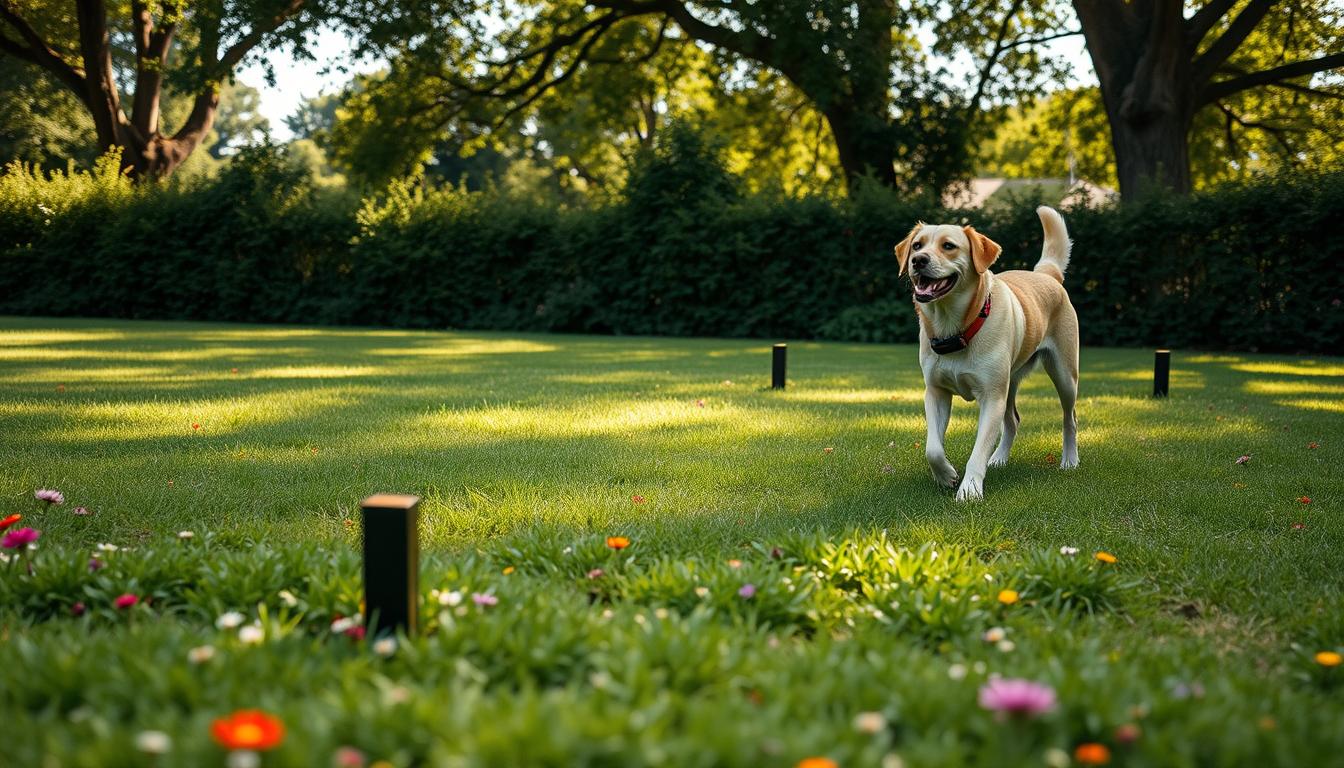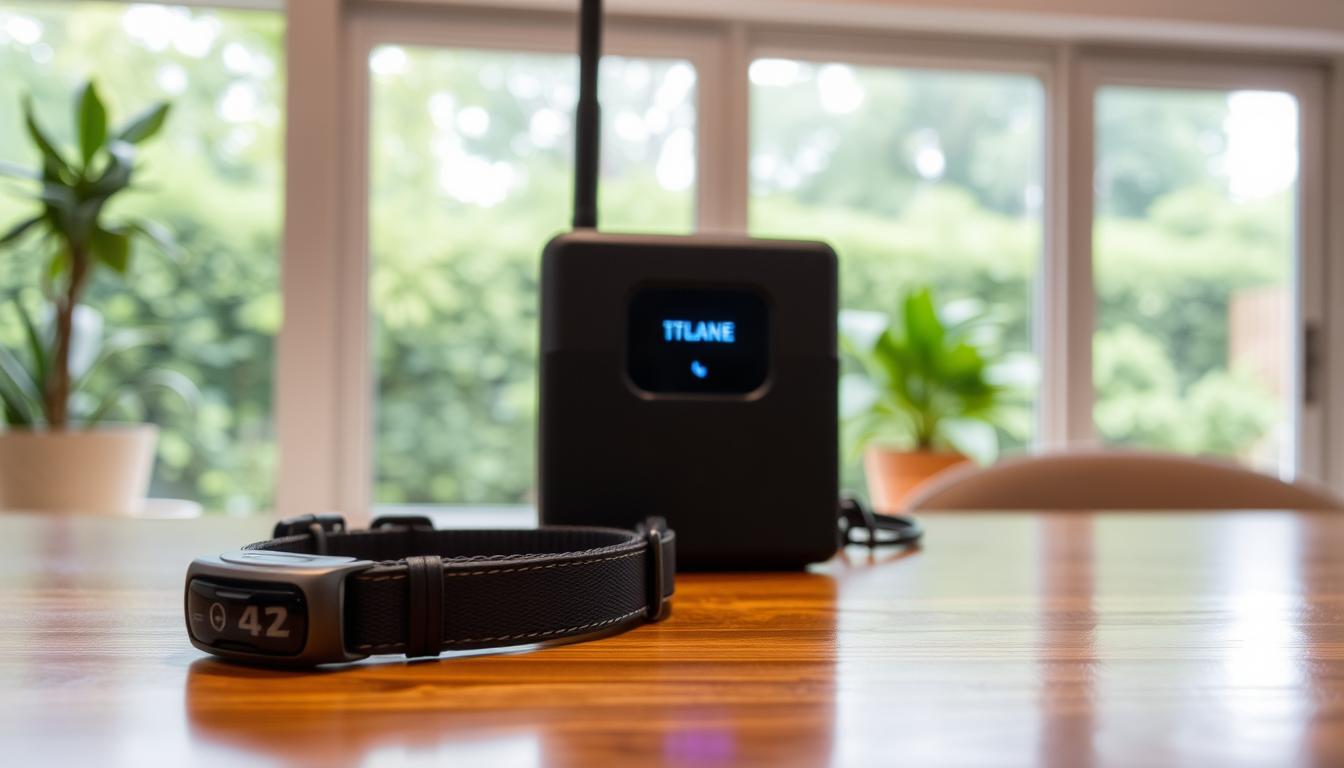Are you looking for a way to give your dog the freedom to roam in your yard while keeping them safe from potential dangers? A wireless dog fence can be an effective solution, providing an invisible barrier that prevents accidents and keeps your dog within your property boundaries.
Choosing the right pet containment system can be overwhelming with the numerous options available. This guide will walk you through the different types of fence systems, key features to consider, and recommendations for various yard sizes, helping you make an informed decision.
Proper training is essential for any dog fence system to be effective. This guide will also cover the importance of training your dog to respond to the fence, ensuring a safe and enjoyable experience for your dog.
Key Takeaways
- Understand the different types of wireless dog fences available.
- Learn how to choose the right containment system for your yard size and dog’s temperament.
- Discover key features to consider when selecting a dog fence system.
- Find out why proper training is crucial for the effectiveness of any dog fence system.
- Get recommendations for various yard sizes to help you make an informed decision.
Understanding Wireless Dog Fences and How They Work
The concept of a wireless dog fence is simple yet innovative, creating an invisible boundary around your property. This system is designed to keep your dog safe while giving them the freedom to roam within a designated area.
What is a Wireless Dog Fence?
A wireless dog fence is a pet containment system that uses a central transmitter to communicate with a receiver collar worn by your dog. This technology creates a circular boundary around your yard, warning your dog when they approach the edge.
How Wireless Dog Fences Keep Your Pet Safe
When your dog approaches the boundary, the receiver collar issues a warning beep. If your dog continues toward the boundary, the collar provides a mild static correction, teaching your dog to respect the boundary. This progressive warning system ensures your dog’s safety.
Benefits of Using a Wireless Dog Fence
Wireless dog fences offer several benefits, including no visual obstruction, lower cost compared to traditional fences, and flexibility for property owners. They provide peace of mind for pet owners while giving dogs the freedom to roam safely within established boundaries.
| Feature | Benefit |
|---|---|
| Invisible Boundary | No visual obstruction, preserving your yard’s aesthetics |
| Adjustable Coverage | Flexibility to adjust the boundary according to your needs |
| Progressive Warning System | Effective training for your dog to respect boundaries |
By understanding how wireless dog fences work, you can make an informed decision about whether this system is right for you and your pet.
Types of Dog Fence Systems for Pet Containment
When it comes to keeping your dog safe, choosing the right pet containment system is crucial. There are three main types of dog fence systems available, each designed to cater to different property sizes, terrains, and specific containment needs.
Wireless Dog Fences
Wireless dog fences use a central transmitter unit to create a circular boundary around your yard, keeping your dog contained within a certain radius. These systems are easy to install and require minimal setup. They are ideal for small to medium-sized yards with minimal obstacles.
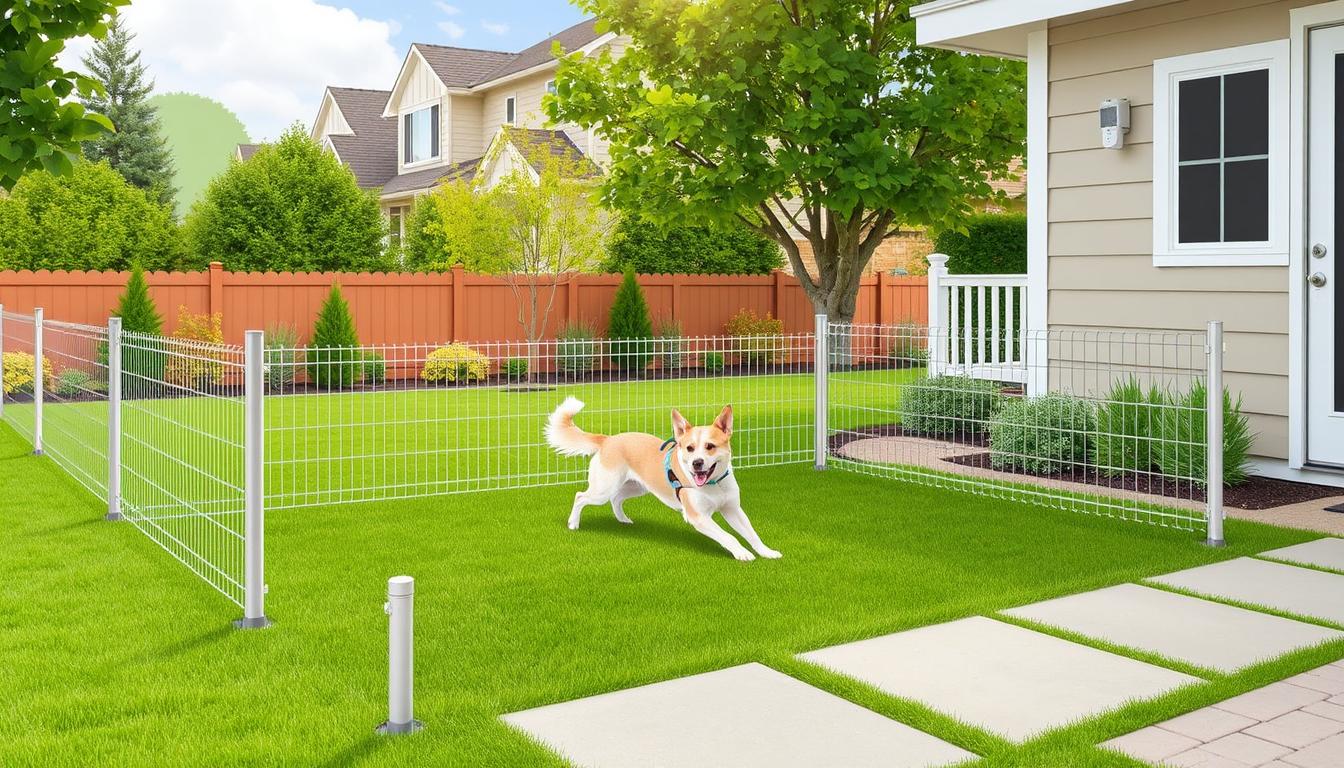
In-Ground Dog Fences
In-ground dog fences involve burying a wire around the perimeter of your property to create a custom boundary. This system is more suitable for larger properties or those with complex layouts, as it allows for precise boundary definition. The buried wire sends a signal to the dog’s collar, alerting them when they approach the boundary.
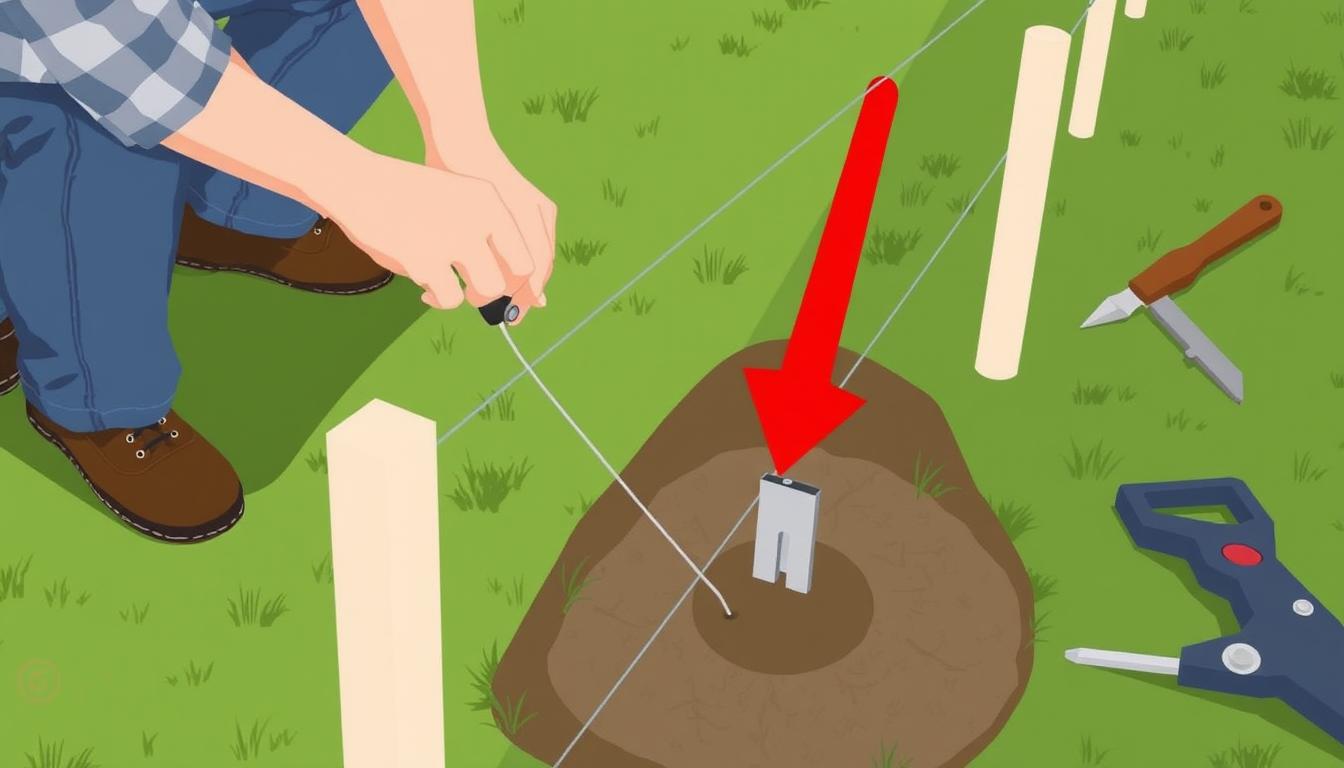
GPS Dog Fences
GPS dog fences utilize satellite technology to create a virtual boundary around your dog, without the need for physical components like wires or a stationary transmitter. These systems offer flexibility and can be used in various locations, making them ideal for active dogs or owners who travel frequently with their pets.

Each of these dog fence systems has its unique characteristics, benefits, and ideal applications. By understanding the differences between wireless, in-ground, and GPS dog fences, you can make an informed decision that best suits your pet’s needs and your property’s layout.
Key Features to Consider When Choosing the Best Wireless Dog Fence
Selecting the perfect wireless dog fence for your yard involves examining several vital characteristics that influence its functionality. When choosing a dog fence system, it’s crucial to consider factors like coverage area, fence type, battery life, and durability to ensure it meets your pet’s needs.
Coverage Area and Boundary Customization
The coverage area of a wireless dog fence is a critical factor, as it determines the size of the yard it can effectively contain. Typically, wireless dog fences cover between ½ to 1½ acres. Consider a system’s ability to customize boundaries to fit your yard’s shape and size. Some systems offer more flexibility than others, so it’s essential to choose one that can be adjusted according to your needs.
Collar Features: Correction Levels, Waterproofing, and Battery Life
The collar is a crucial component of any wireless dog fence. Look for collars with adjustable correction levels to tailor the training to your dog’s temperament. Waterproofing is also vital for active dogs that may be exposed to water. Additionally, consider the battery life to ensure it lasts long enough to avoid frequent recharging or replacement.
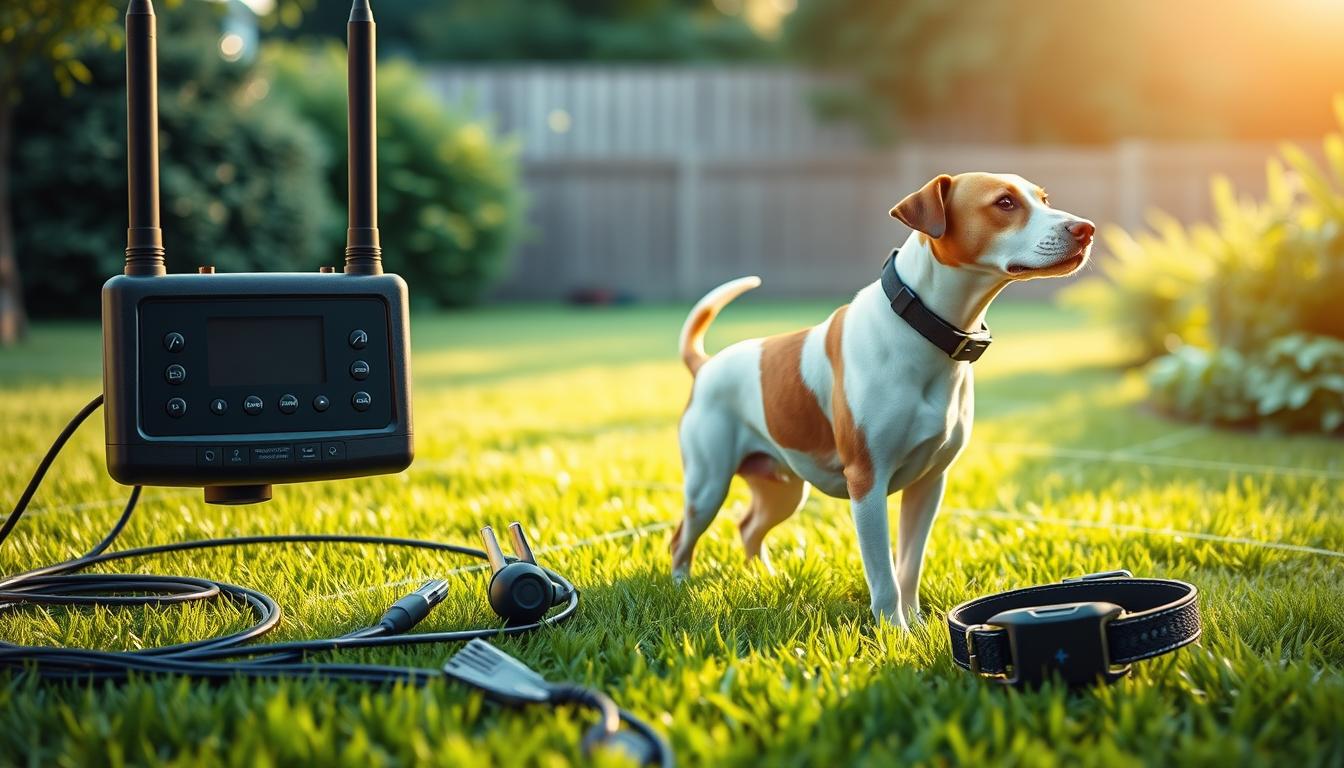
Ease of Installation and Portability
The ease of installation varies significantly between different dog fence systems. Wireless dog fences are generally the simplest to install, requiring minimal setup. In contrast, in-ground systems demand more effort but offer greater customization. If you travel frequently or have multiple properties, consider the portability of the system to ensure it can be easily moved.
Multiple Dog Support
For households with more than one dog, it’s essential to choose a system that supports multiple dogs. Many wireless dog fences offer additional collars, making it easy to manage multiple pets. This feature can be particularly beneficial for families with several dogs, ensuring each pet is safely contained within the designated boundary.
Best Wireless Dog Fences for Different Yard Sizes
Different yard sizes require different wireless dog fence systems. Whether you have a small, medium, or large yard, there’s a wireless dog fence designed to meet your needs and keep your pet safe.
PetSafe Wireless Pet Fence for Small Yards
The PetSafe Wireless Pet Fence is ideal for small yards, covering up to ½ acre with an adjustable circular boundary. This system is easy to set up and provides a reliable way to keep your dog within the designated area.
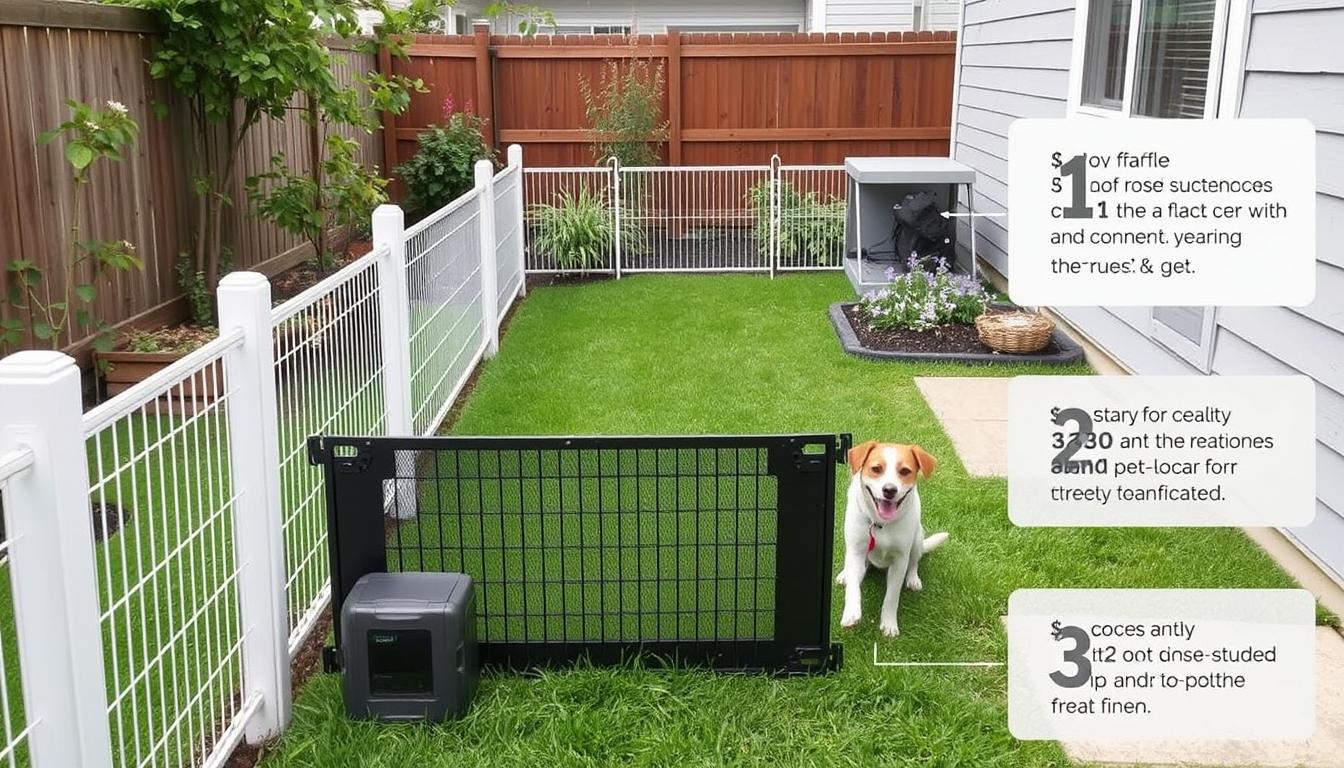
PetSafe Stay and Play Wireless Pet Fence for Medium Yards
For medium-sized yards, the PetSafe Stay and Play Wireless Pet Fence offers coverage up to ¾ acre. Its portable transmitter makes it easy to set up and adjust as needed, providing flexibility and convenience.
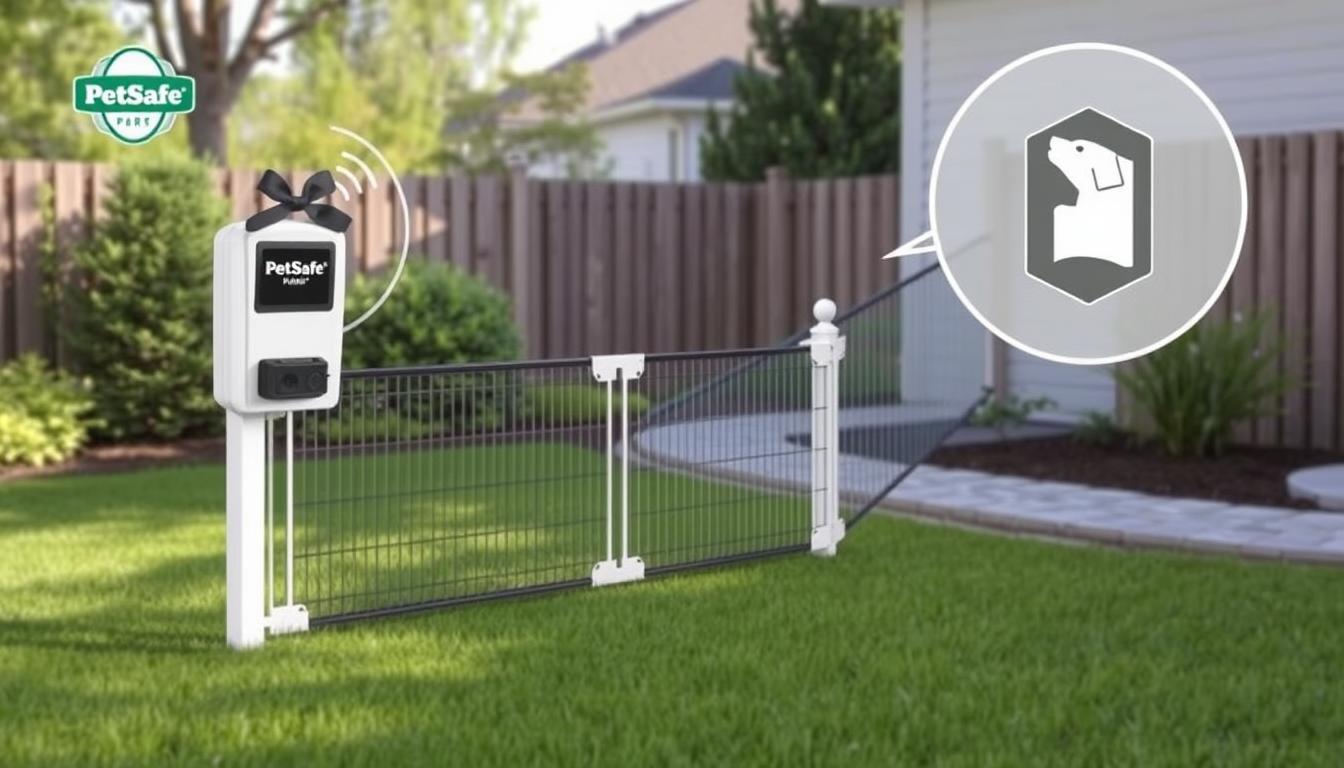
SportDOG Brand Wireless Systems for Larger Properties
SportDOG Brand Wireless Systems are designed for larger properties, covering up to 1½ acres. These systems feature adjustable boundaries and stronger correction settings, making them suitable for larger dogs.

When choosing a wireless dog fence, it’s essential to consider factors such as correction levels, battery life, and reliability. Additionally, be aware of the limitations of wireless systems, including circular-only boundaries and potential signal interference.
Top In-Ground Dog Fence Options for Custom Boundaries
In-ground dog fences provide a superior level of customization and boundary control, making them an ideal choice for yards with irregular shapes.
SportDOG Brand Rechargeable In-Ground Fence Systems
The SportDOG Brand Rechargeable In-Ground Fence System is a robust in-ground dog fence solution that offers custom boundaries and reliable containment. With its rechargeable battery, this system can cover up to 100 acres with additional wire, making it suitable for larger properties.
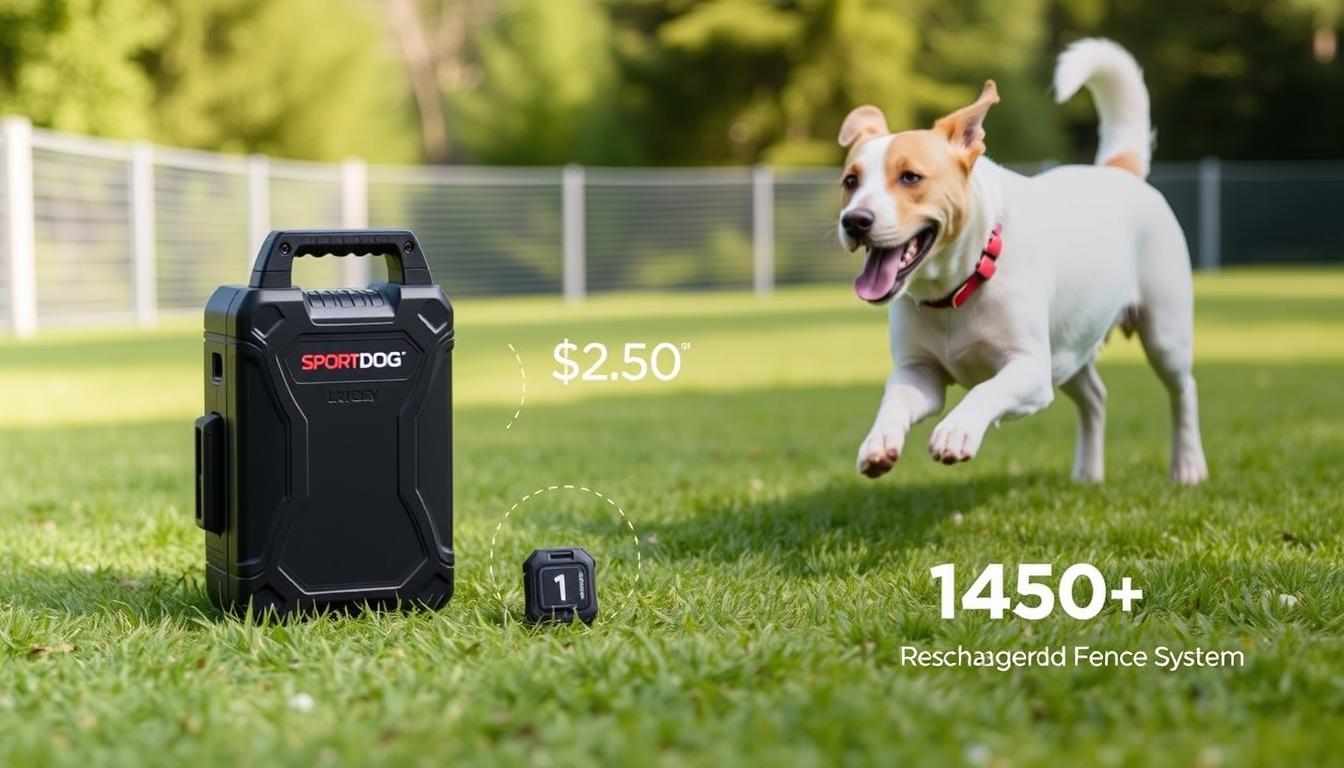
Extreme Dog Fence for Durability and Reliability
The Extreme Dog Fence Kit is designed with durability in mind, featuring heavy-duty buried wire that resists weather damage and wear. This dog fence system supports multiple dogs with additional fence collars, making it a versatile option for pet owners.
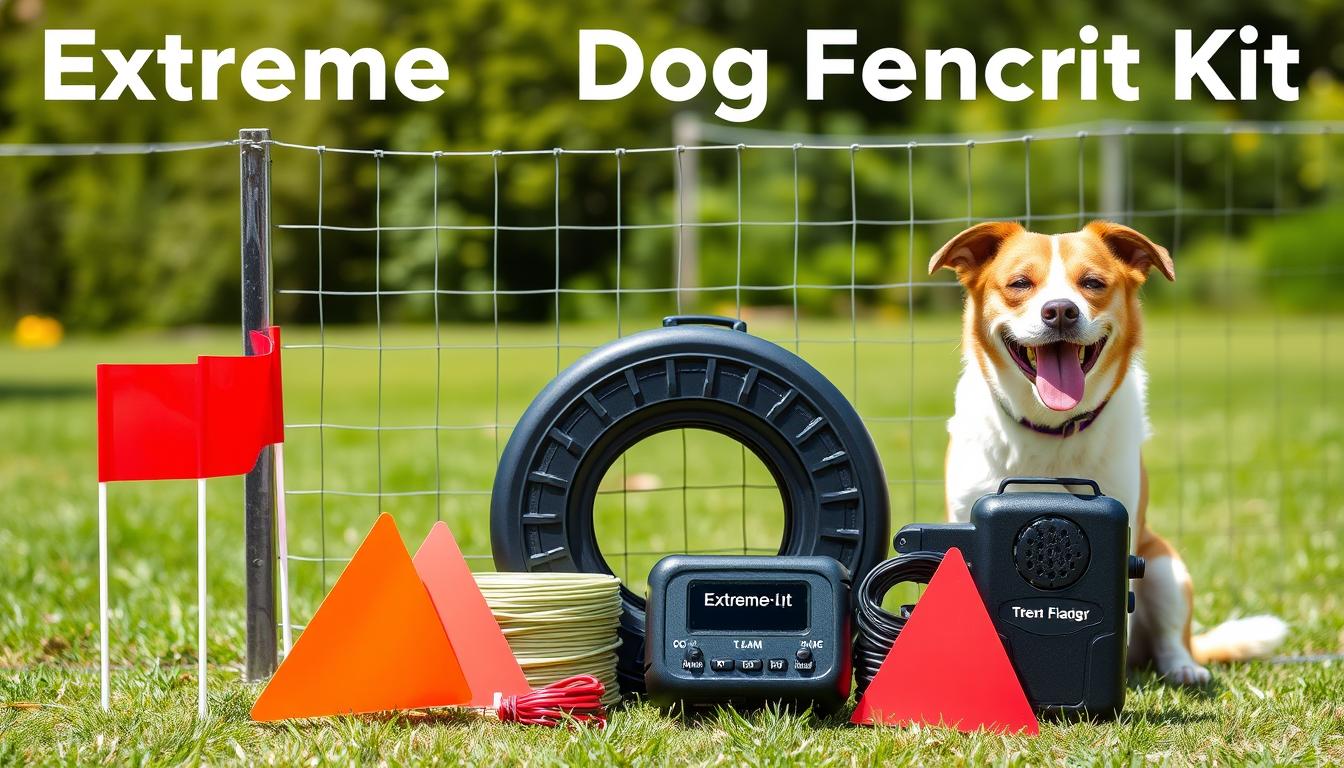
In-ground dog fence systems like these offer superior customization for irregularly shaped yards and precise boundary control. They are particularly beneficial for pet owners who need a reliable containment solution that can be tailored to their specific property layout.
When choosing an in-ground dog fence, consider factors such as coverage area, correction levels, and battery life. The SportDOG Brand rechargeable in-ground fence system, for example, features stronger static correction settings for stubborn dogs, ensuring effective training and containment.
Installation requirements for in-ground systems include trenching depth, wire protection options, and typical setup time. While these systems can be more labor-intensive to install, they offer long-term reliability and durability.
Advanced GPS Dog Fence Solutions
The newest generation of dog fences utilizes GPS to provide customizable and reliable pet containment. Advanced GPS dog fence technology is revolutionizing the way we keep our pets safe, offering flexibility and accuracy that traditional fencing methods can’t match.
Halo Collar4 – Smart Features and Activity Tracking
The Halo Collar4 is a cutting-edge GPS dog fence that doubles as a training collar, featuring tone, vibration, and static correction. It works seamlessly with Bluetooth, Wi-Fi, and real-time GPS signals, integrating with a mobile app for easy adjustments and monitoring. With its advanced tracking capabilities, you can keep tabs on your dog’s location and activity levels.

SpotOn GPS Dog Fence – Customizable Boundaries Without Wires
The SpotOn GPS Dog Fence offers a wire-free solution for pet containment, utilizing GPS tracking to create customizable fence boundaries. This system is ideal for properties of any size and features a waterproof, rechargeable collar with long battery life. With the SpotOn GPS Dog Fence, you can create multiple custom-shaped boundaries without the need for physical wires or base stations.

When choosing a GPS dog fence, it’s essential to consider the subscription models required for these systems, as they often include various features at different price points. Additionally, the accuracy and reliability of GPS systems can vary in different environments, such as heavily wooded areas or locations with poor satellite coverage.
Installation and Training Tips for Wireless Dog Fences
The key to a successful wireless dog fence lies in its installation and how well your dog is trained to respect its boundaries. Proper setup and training are essential for effective containment.
Setting Up Your Wireless Dog Fence System
To set up your wireless dog fence system, start by placing the transmitter indoors, at least 3 feet away from metal objects, appliances, and Wi-Fi routers to prevent interference. Follow the manufacturer’s instructions for configuring the boundary and testing the signal strength. Ensure the area is clear of obstructions to maximize coverage.
Training Your Dog to Respect Boundaries
Training your dog typically takes about two weeks. Begin by introducing your dog to the boundary using flag markers and leashed walks. Gradually progress from tone-only warnings to correction levels as your dog learns to respect the invisible boundary. Consistency and positive reinforcement are key.
Troubleshooting Common Issues
Common issues with wireless dog fences include inconsistent boundaries, collar fit problems, and battery maintenance. Check the transmitter’s power source and ensure the collar fits comfortably. Regularly inspect the system for any malfunctions and adjust as necessary.
| Issue | Solution |
|---|---|
| Inconsistent Boundaries | Adjust transmitter placement and check for interference. |
| Collar Fit Problems | Ensure a comfortable fit and adjust as necessary. |
| Battery Maintenance | Regularly check and replace batteries as needed. |
By following these installation and training tips, you can ensure your wireless dog fence operates effectively, keeping your dog safe within the designated boundary.
Wireless vs. In-Ground vs. GPS: Which Dog Fence is Right for You?
The quest for the perfect dog fence involves evaluating the pros and cons of wireless, in-ground, and GPS technologies to ensure your dog’s safety and happiness. When deciding, it’s crucial to consider several factors, including cost, reliability, and your dog’s temperament.
Comparing Cost, Reliability, and Maintenance
When comparing dog fences, cost is a significant factor. Wireless dog fences are often the most affordable upfront, while GPS dog fences can be more expensive due to the advanced technology. In-ground fences fall somewhere in between, depending on the complexity of the installation. Reliability varies across the three types, with in-ground fences being less susceptible to signal interference and GPS fences offering flexibility and customization. Maintenance also differs; wireless systems require minimal upkeep, whereas in-ground fences need periodic checks on the buried wires.

Best Options for Different Dog Temperaments
Your dog’s temperament plays a crucial role in choosing the right fence. For easily distracted or highly motivated dogs, a physical or in-ground fence might be more effective due to its reliability. GPS dog fences, on the other hand, offer customizable boundaries that can be ideal for dogs that require more flexibility in their containment area.
Considerations for Property Type and Location
The size, terrain, and landscaping of your property, as well as its proximity to roads, significantly influence the choice of dog fence. For large properties or areas with complex terrain, GPS dog fences can provide the necessary coverage without the need for physical barriers. In contrast, for smaller, more manageable areas, wireless or in-ground fences might suffice.
Conclusion
The key to successful pet containment lies in selecting a dog fence that aligns with your yard size, dog’s temperament, and lifestyle needs. To conclude, the right dog fence is crucial for your pet’s safety and freedom. The best wireless dog fence or alternative containment system depends on several factors, including your yard size, dog’s temperament, and training needs.
When choosing a dog fence, consider the different options available, such as wireless fences, in-ground fences, and GPS fences. Each offers unique benefits and is suited for various scenarios. The size of your yard and your dog’s temperament play a significant role in determining the most suitable dog fence for your needs.
Proper installation and training are essential for the success of any containment system. A wireless dog fence is not a replacement for consistent training but rather a tool that works in conjunction with it. Consider your long-term needs, including potential moves or additional pets, when selecting a dog fence system.
In summary, finding the ideal pet containment solution requires careful consideration of your specific needs and circumstances. By choosing a fence that matches your property size, dog’s temperament, and lifestyle, you can ensure your pet’s safety while giving them the freedom to roam. A collar that works with your chosen containment system is also crucial.
Ultimately, the best option for you will depend on your specific situation, but with the right information and a well-chosen dog fence, you can create a safe and enjoyable environment for your pet.
FAQ
How do I know if a wireless dog fence is right for my yard?
To determine if a wireless dog fence is suitable for your yard, consider the size of your property and the level of customization you need. Wireless dog fences are ideal for smaller to medium-sized yards and offer ease of installation.
What is the average battery life of a training collar used with a wireless dog fence?
The battery life of a training collar varies depending on the model and usage. Typically, you can expect a battery life ranging from several months to a year or more, with some rechargeable options available.
Can I add additional collars to my wireless dog fence system?
Yes, many wireless dog fence systems allow you to add extra collars, making it convenient to train multiple dogs. Check the specifications of your system to see how many additional collars it supports.
Are wireless dog fences waterproof?
Most modern wireless dog fences and their associated collars are designed to be waterproof or water-resistant. However, it’s essential to check the product specifications to ensure it meets your needs.
How do I adjust the boundary of my wireless dog fence?
Adjusting the boundary of your wireless dog fence typically involves using the transmitter’s controls or a companion app to modify the signal range. Some systems may require physical adjustments to the transmitter’s location or settings.
What kind of correction levels can I expect from a wireless dog fence?
Wireless dog fences often come with adjustable correction levels, ranging from a simple beep or vibration to a static correction. The level of correction can usually be customized to suit your dog’s temperament and training needs.
Can I use a wireless dog fence with a GPS-enabled collar?
While some systems combine elements of both wireless and GPS technology, a traditional wireless dog fence typically does not use GPS. However, there are GPS-enabled dog fences available that offer more advanced features and flexibility.
How do I troubleshoot common issues with my wireless dog fence?
Troubleshooting common issues with your wireless dog fence may involve checking the transmitter’s power, ensuring the collar is properly fitted, and adjusting the boundary settings. Consult your user manual or manufacturer’s support resources for specific guidance.

